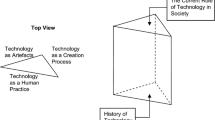Abstract
We are living in a fast-changing, technology-driven world, where technology affects the daily lives of every person, directly or indirectly. While the importance of providing young children with technological knowledge and experience has been well-recognized, how the curriculum should be developed deserves greater study. Using early childhood education in Hong Kong as a case study, this paper argues that to be successful in planning and implementing a technology curriculum, we cannot consider only the technological aspects. We also need to take into consideration the social and cultural factors. Among various social and cultural factors, this paper focuses on: (a) the background of the students and their parents, (b) society’s perceptions of technology, and (c) society’s expectations of children who learn about technology, and (d) the approach and method of teaching and learning technology.
Similar content being viewed by others
Notes
The Hong Kong Special Administrative Region (SAR) is part of China. As such, people moving from mainland China are not considered immigrants. “New arrivals” and “new arrival family” are the official terms to describe this group of people who have settled in Hong Kong from mainland China.
From the 1960s to the early 1980s, secondary technical schools in Hong Kong focused on training students in crafts and skills. The students who studied these schools could learn some basic skills, which make it easier for them to get a place in a technical institute or to get a job (Siu, 2002).
REFERENCES
Browne, N. (1991). Science and technology in the early years: An equal opportunities approach. Milton Keynes, Philadelphia, PA: Open University Press
Census and Statistics Department. (2001). Tab on CD ROM. Hong Kong: Census and Statistics Department
Custer, R. L. (1995). Examining the dimensions of technology. International Journal of Technology and Design Education, 5, 219–244
Eggleston, J. (2001). Teaching design and technology (3rd ed.). Buckingham, UK: Open University
Fleer M., & Sukroo, J. (1995). I can make my robot dance: Technology for 3–8 year olds. Carlton, VIC: Curriculum Corporation
Harnqvist, K., & Burgen, A. (1997). Growing up with science: Developing early understanding of science. Jessica London: Kingsley Publishers and Academia Europaea
Haugland, S. W., & Wright, J. L. (1997). Young children and technology: A world of discovery. Needham Heights, MA: Allyn and Bacon
Housing Authority and Housing Department. (2004). Available: http://www.housingauthority.gov.hk/en
Johnston, J. (1996). Early explorations in science. Buckingham: Open University Press
Kwok, Y. C. J. (2003). The weight of the living environment: Participatory design research for habitable space with new arrival women in Hong Kong. Hong Kong: Research Group on Urban Space and Culture, The Hong Kong Polytechnic University; and The Boys’ and Girls’ Clubs Association of Hong Kong
Raizen, S. A., Sellwood, P., Todd, R., & Vickers, M. (1995). Technology education in the classroom: Understanding the designed world. San Francisco, CA: Jossey-Bass
Siu, K. W. M. (2000). Eight percent of design and technology students in our class. The Journal of Design and Technology Education, 51, 20–25
Siu, K. W. M. (2002). Impact of new technology on teaching and learning in technology education: Opportunity or threat? In E. W. L. Norman (Ed.), DATA International Research Conference 2002 (pp. 29–37). Wellesbourne: The Design and Technology Association
Siu, K. W. M., & Lam, M. S. (2003). Technology education in Hong Kong: International implications for implementing the “Eight Cs” in the early childhood curriculum. Early Childhood Education Journal, 31, 143–150
Williams, R. (2002). Retooling: A historian confronts technological change. Cambridge, MA: The MIT Press
Wright, J. L., & Shade, D. D. (1994). Young children: Active learners in a technological age. Washington, DC: National Association for the Education of Young Children
ACKNOWLEDGMENTS
The authors would like to acknowledge the support they received from The Hong Kong Polytechnic University and The Hong Kong Institute of Education to conduct this study. The authors would also like to thank for late Professor John Eggleston for his advices and comments on technology education for children and young people. The original version of this paper was presented in the 3rd Hawaii International Conference on Education.
Author information
Authors and Affiliations
Rights and permissions
About this article
Cite this article
Siu, K.W.M., Lam, M.S. Early Childhood Technology Education: A Sociocultural Perspective. Early Childhood Educ J 32, 353–358 (2005). https://doi.org/10.1007/s10643-005-0003-9
Published:
Issue Date:
DOI: https://doi.org/10.1007/s10643-005-0003-9




